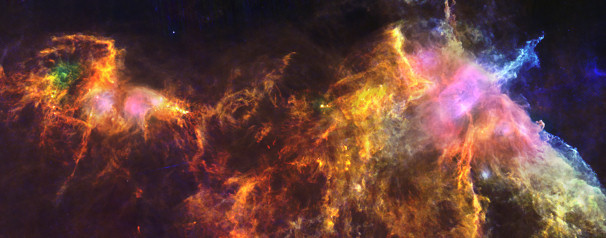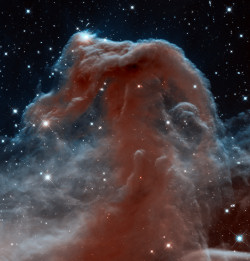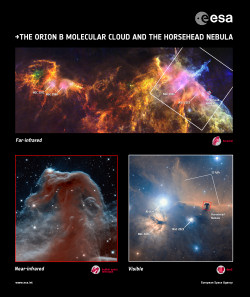A Horsehead, a Flame and hidden gems in Orion B
 |
Near Alnitak, the leftmost star in Orion's Belt, and extending almost perpendicular, on the plane of the sky, to the three stars in the Belt is a huge star-forming complex, hidden to visible wavelengths. This massive stellar nursery, known as the Orion B molecular cloud, reveals itself through the glow of cosmic dust in the interstellar material that pervades it. Heated by radiation from newborn stars, the dust shines brightly at far-infrared wavelengths, revealing a tangled network of filaments.
Astronomers have used ESA's Herschel Space Observatory to map the structure of the cloud, which at about 1300 light-years is one of the closest regions of star formation. The detailed far-infrared image of the area allows astronomers to investigate the various phenomena that lead to stellar birth.
The intricate structure of Orion B is due to a number of factors. Gravity causes clumps of matter to grow denser and eventually collapse, forming stars; winds and radiation from stars that have already been born produce the opposite result, pushing matter away. Meanwhile, magnetic fields may induce turbulence and stir the cloud material, smoothing out denser structures and complicating the process of stellar formation.
The bright yellow, white and pink areas in the image are the densest regions, where many protostars and newborn stars are found. Darker regions correspond to colder portions of the cloud where star formation is not as active. On the right side of the image, the cloud exhibits a very sharp edge where the material in Orion B is being compressed by powerful winds blowing from clusters of massive stars located beyond the field of this image.
 |
|
Hubble's view of the Horsehead Nebula. Credit: NASA, ESA, and the Hubble Heritage Team (AURA/STScI) |
These mighty stellar winds have sculpted the iconic Horsehead Nebula, glowing brightly on the right-hand edge of the Herschel image. This thick pillar of gas and dust was first identified in the 1880s by astronomer Williamina Fleming as she compiled one of the first astronomical catalogues based on photographic observations. In the image she used, taken at visible wavelengths, the Horsehead Nebula stood out as a silhouette against the diffuse glow of the IC 434 nebula. Later investigations would reveal that like other 'dark nebulae', the Horsehead Nebula consists of material so dense that it blocks visible light from background stars or surrounding clouds. Inside the dense dark nebulae, stars are on the verge of being born. The brighter IC 434 is an 'emission nebula', which radiates as its gas is ionised by ultraviolet light from nearby massive stars.
The detailed structure of the Horsehead Nebula is revealed by a near-infrared image from the NASA/ESA Hubble Space Telescope. At these wavelengths, light is much less absorbed by the material of the nebula, so the distribution of gas that will develop into stars is exposed, along with the gleam from stars located either within the nebula or in the background. The bright source at the top left edge of the nebula is a young star that has taken shape from the cloud and whose radiation is already eroding the surrounding interstellar material.
Herschel's far-infrared view of Orion B also shows other pockets of star-forming gas and dust nestled in the intricate structure of this cloud. One of them is the emission nebula NGC 2024, also known as the Flame Nebula. It was originally discovered in the late 18th century by William Herschel, the astronomer after whom the Herschel Space Observatory is named. At visible wavelengths the Flame Nebula appears as a bright region crossed by prominent dark lanes, but the far-infrared view reveals the opposite structure. The dense concentrations of material that obscure visible light shine most brightly at the longer, far-infrared wavelengths, indicating that intense star formation is ongoing.
Between the Horsehead and Flame Nebulae is the star-forming region of NGC 2023, while NGC 2071 and NGC 2068 can be seen as the two glowing (pink) areas on the left of the Herschel image. All three are 'reflection nebulae' and also shine brightly at visible wavelengths because light from nearby stars permeates them. The stellar light is not energetic enough to ionise the gas in these clouds – as happens in reflection nebulae – but scatters off the cloud material causing it to glow. Like the Flame Nebula, these three clouds were discovered at the end of the 18th century – NGC 2023 and NGC 2071 by William Herschel, and NGC 2068 by astronomer Pierre Mechain.
While astronomers have long been familiar with individual nebulae in the Orion B molecular cloud, a comprehensive view of this star-forming region can only be grasped with far-infrared observations. Herschel's new image allows astronomers to place the various nebulae in a grander context and to research the detailed mechanisms powering this prolific stellar nursery.
| Fast Facts | |
| Depicted object: | Orion B molecular cloud |
| Additional details: | Several nebulae are hosted in this cloud: from left to right, the reflection nebulae NGC 2071 and NGC 2068, the emission nebula NGC 2024 (also known as Flame Nebula), the reflection nebula NGC 2023 and the dark nebula IC 434 (also known as Horsehead Nebula) |
| Constellation: | Orion (the Hunter) |
| Distance: | about 1300 light years |
| Image | |
| Satellite: | Herschel |
| Instruments: | PACS; SPIRE |
| Wavelengths: | 70 μm (PACS; blue); 160 μm (PACS; green); 250 μm (SPIRE; red) |
| Field of view: | about 4.5 degrees times 1.5 degrees |
| Image Orientation: | North is about 45 degrees clockwise of the leftward direction; East is about 45 degrees counterclockwise of the leftward direction |
| Observation dates: | 29 September 2010; 13 March 2011 |
| Release date: | 18 April 2013 |
| Credit: | ESA/Herschel/PACS, SPIRE/N. Schneider, Ph. André, V. Könyves (CEA Saclay, France) for the "Gould Belt survey" Key Programme |
| Acknowledgments: | "Gould Belt Survey" Key Programme (PI: Ph. André) |
| Satellite: | Hubble |
| Instruments: | WFC3 |
| Wavelengths: | 1.1 μm (blue/cyan); 1.6 μm (red/orange) |
| Field of view: | about 6 arc minutes across |
| Image Orientation: | North is to the left; East is down |
| Release date: | 18 April 2013 |
| Credit: | NASA, ESA, and the Hubble Heritage Team (AURA/STScI) |
Related publications
N. Schneider, et al., 2013, "What determines the density structure of molecular clouds? A case study of Orion B with Herschel", The Astrophysical Journal Letters, Volume 766, Issue 2, article id. L17, DOI:10.1088/2041-8205/766/2/L17
André, Ph., et al., 2010, "From filamentary clouds to prestellar cores to the stellar IMF:
Initial highlights from the Herschel Gould belt survey", A&A, 518, L102, DOI:10.1051/0004-6361/201014666
Contacts
Göran Pilbratt
Herschel Project Scientist
Research and Scientific Support Department
Science and Robotic Exploration Directorate
ESA, The Netherlands
Email: gpilbratt![]() rssd.esa.int
rssd.esa.int
Phone: +31-71-565-3621





